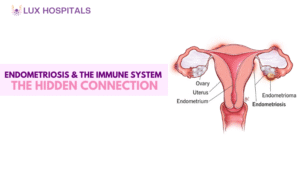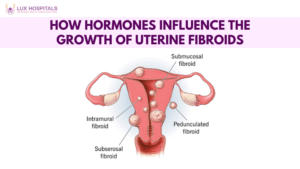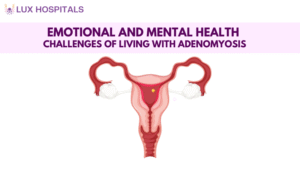How Uterine Fibroids Affect Women’s Health and Fertility

Common benign tumors in the uterus, particularly in women of reproductive age, are called uterine fibroids. Despite not being malignant, they can seriously impair reproductive capacity and regular body processes. In addition to offering insights into practical management techniques, this blog provides a comprehensive analysis of how uterine fibroids can impact a woman’s overall quality of life, fertility, and health.
What Are Uterine Fibroids?
Uterine fibroids are firm, dense growths made of smooth muscle and connective tissue. They can appear inside the uterus (submucosal), on its outer wall (subserosal), or within the muscle layer (intramural). Some fibroids grow individually, while others appear in clusters. Their development is strongly linked to estrogen and progesterone levels, which is why they often shrink after menopause. Knowing the type of fibroid you have is crucial for selecting the most effective treatment.
Common Symptoms of Uterine Fibroids
The symptoms of uterine fibroids can range from mild to severe. While some women may never know they have fibroids, others suffer from constant discomfort and menstrual issues.
- Heavy menstrual bleeding can lead to anemia, fatigue, and social withdrawal.
- Pelvic pressure can make daily activities difficult and painful.
- Urinary frequency or urgency may occur due to fibroids pressing on the bladder.
- Pain during intercourse or persistent back pain may signal deep-seated fibroids.
- Bloating or visible abdominal enlargement can also develop in extreme cases.
If you experience multiple of these symptoms, especially over a prolonged period, consult a healthcare provider to evaluate for uterine fibroids.
How Uterine Fibroids Affect Women’s Health
A woman’s health may suffer both physically and psychologically as a result of uterine fibroids. Work, relationships, and self-esteem can all be negatively impacted by chronic pain, irregular menstruation, and exhaustion from blood loss.
Health Complications Include:
- Anemia from heavy bleeding causes weakness and dizziness.
- Urinary infections are often caused by incomplete bladder emptying.
- Constipation or bloating from pressure on the intestines.
- Sleep disturbances, irritability, and mood swings due to ongoing pain.
- Chronic fatigue can reduce productivity and increase depression or anxiety.
Uterine fibroids may present long-term health risks if treatment is not received, especially if symptoms worsen or increase in frequency over time, particularly if symptoms intensify or become more frequent over time.
Uterine Fibroids and Fertility
One of the most concerning aspects of uterine fibroids is their effect on fertility. Their interference with reproductive anatomy can delay or prevent conception altogether.
Ways Fibroids Can Affect Fertility:
- Obstruction of the fallopian tubes can prevent the egg and sperm from meeting.
- Submucosal fibroids may disrupt the uterine lining, hindering implantation.
- Changes in blood flow to the uterine cavity may affect embryo development.
- Cervical shape alteration may impede sperm travel.
In many cases, removing uterine fibroids can dramatically raise the likelihood of a spontaneous conception and enhance fertility results.
How Pregnancy Is Affected by Uterine Fibroids
Pregnancy with uterine fibroids is possible, but the journey may come with extra challenges. Increased hormone levels during pregnancy may accelerate the growth of fibroids and intensify their discomfort.
Potential Complications Include:
- Miscarriage or early labor due to uterine contractions.
- Restricted fetal growth is caused by limited space in the uterus.
- Placenta previa or abruption can cause serious complications.
- Pain from fibroid degeneration can require hospitalization during pregnancy.
For pregnant women with uterine fibroids, doctors may advise more frequent prenatal visits so that any additional hazards can be addressed at an early stage. with uterine fibroids so that any new risks can be addressed early.
Diagnosis of Uterine Fibroids
Early detection of uterine fibroids aids in improved symptom management and fertility planning. Imaging tests are typically performed after a pelvic exam.
Diagnostic Tools:
- Ultrasound is commonly used to confirm the size, shape, and location of fibroids.
- MRI offers a more detailed view of complex or multiple fibroids.
- Hysteroscopy enables direct visualization of fibroids within the uterus.
- Blood tests may be used to detect anemia caused by excessive blood loss.
Timely diagnosis of uterine fibroids allows women to weigh treatment options before complications worsen.
Treatment Options for Uterine Fibroids
The woman’s age, symptoms, fibroid size, and fertility objectives all influence the highly customized therapy options for uterine fibroids. Part of the highly individualized uterine fibroids treatment options.
Treatment Options Include:
- Hormonal medications can help reduce bleeding and temporarily shrink fibroids.
- Uterine artery embolization (UAE) cuts the blood supply to fibroids, causing them to shrink.
- Myomectomy is the surgical removal of fibroids while preserving the uterus.
- A hysterectomy may be considered when symptoms are severe and fertility is not a concern.
Choosing the proper treatment for uterine fibroids is essential for symptom relief and maintaining reproductive potential.
Lifestyle and Natural Remedies
Although there is no natural treatment for uterine fibroids, specific lifestyle changes can help manage their growth and reduce discomfort. They can cause symptoms and impede the progression of the disease, but they cannot cure it.
Helpful Changes Include:
- Anti-inflammatory diets are rich in leafy greens, berries, and whole grains.
- Weight management can help reduce estrogen levels in the body.
- Regular exercise improves circulation and hormone balance.
- Limiting alcohol and caffeine can help regulate hormones.
Managing uterine fibroids with lifestyle adjustments may be most effective when combined with medical treatment.
When to See a Doctor?
Knowing when to seek help is key to preventing uterine fibroids from worsening. Don’t ignore chronic discomfort or abnormal bleeding.
Consult a Doctor If You Experience:
- Bleeding in between cycles or periods longer than seven days.
- Severe pelvic pain or pressure disrupting daily activities.
- Repeated miscarriages or trouble conceiving without explanation.
- A noticeable abdominal lump or swelling.
Prompt medical attention ensures early detection and better outcomes in managing uterine fibroids.
Conclusion
Uterine fibroids can greatly impact the physical and reproductive health of a woman. Their effects, which range from severe bleeding and anemia to problems with fertility and pregnancy difficulties, should not be misunderstood. However, preventing long-term issues requires awareness and prompt action. There are several treatment methods available, whether you’re attempting to conceive or want to get rid of disturbing symptoms.
Frequently Asked Questions
Uterine fibroids may cause infertility by damaging the lining of the fallopian tubes or uterus. The scope is often determined by their location and size. Treatment can increase the likelihood of getting pregnant. Some women may naturally become pregnant after fibroid resection.
Treatment is not required for every uterine fibroid. If they're small and asymptomatic, routine observation might be enough. When they interfere with fertility or health, treatment is needed. To track growth, your doctor may suggest ultrasounds every six to twelve months.
Some uterine fibroids shrink naturally after menopause as hormone levels drop. While diet and exercise may help slow the growth of fibroids, medical therapy may be necessary for larger fibroids. Always consult a doctor for guidance. Herbal remedies and supplements are not scientifically proven, but they may offer some relief.
Uterine fibroids are benign and rarely turn cancerous. Seldom does a similar growth called leiomyosarcoma develop, but it is highly uncommon. Regular screening helps ensure safety. If a fibroid grows rapidly after menopause, doctors may investigate further for her. Imaging and biopsy may be used to rule out malignancy.
Myomectomy is the most recommended option for women wishing to conceive. It removes the fibroids while preserving the uterus. Other treatments might affect fertility. Hormone therapies can be used temporarily before surgery to shrink fibroids.
Uterine fibroids can return, particularly if hormone levels are elevated. Recurrence is more likely to occur in women with numerous fibroids. Monitoring regression with follow-up care is essential. Hormonal balance and lifestyle modifications may help lower the chance of recurrence. Your physician could advise routine examinations and imaging studies. following surgery.




















